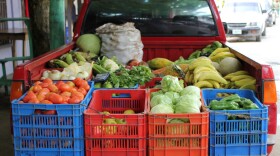The steaks stacked in the coolers of butcher shops in New York may be marketed as local, but just what that label means varies widely.
The state actually has no definition for classifying whether beef sold under that label is locally produced; the duty of deciding what's local falls to the store selling the meat.
Cattle raising in New York state is pretty modest by Texan standards (which had more than 4 million at the start of the year). There are about 6,000 New York farmers raising 90,000 cattle, according to the Department of Agriculture census. That averages out to about two dozen cattle per farmer.But only about a third of those cattle will spend their whole lives in New York and end up on dinner plates here, according to Mike Baker, beef expert at the Cornell Cooperative Extension. There are two main reasons for that, he says.
While New York farmland is good for grazing cattle, Baker explains, the state’s short growing season means it's expensive to finish them, or feed them on grain the final months before slaughter. So it’s cheaper for farmers to ship their cattle out to the Mid-West where they’re finished on corn.
"They’ll be slaughtered out [in] Nebraska, Colorado," Baker says. "And then, of course, we’ve got the population center on the East Coast so the beef comes back here."
And then for the cattle that are finished here in New York, it can be tough to get them into slaughterhouses. Most cattle will be ready for slaughter around the same time of the year - in the fall - and there's not enough capacity at the state's 40 or so slaughterhouses. Farmers have to make appointments six to eight months in advance, according to the New York Beef Producers Association.
That means a lot of cattle end up being sent south to Pennsylvania where there are two commercial scale slaughterhouses. From there, the beef enters the national food chain.
'Thank you for being a farmer'
But there are farmers in New York that are trying to raise their cattle locally and sell them close by.
Eve Ann Schwartz feeds a few younger steers in her barn at Maple Avenue Farms in Earlville, N.Y. before heading out to the fields, where most of her cattle are grazing.
The Schwartz's have one of the larger cattle farms in Madison County, with a few hundred cattle. They do all their own calving, finishing and marketing of their beef.

On a rainy spring afternoon, Schwartz and her farm hand are heading to the top of her hilly farm to move part of her herd to a lower field. Shouts of "hidy up!" and "let's go!" ring out as the cattle begin to slowly move in the same direction. The cattle match Schwartz's noisemaking with plenty of mooing of their own.
Schwartz sends her cattle to a local slaughterhouse and gets it back for packaging. Maple Avenue sends all their beef to a few boutique markets in New York City. The farm falls within a 250 mile radius the stores draw to find their local products.
"I don’t think there’s anything better than standing at the farmers market in New York City and having the customer say, ‘thank you so much for coming down here and selling us our beef. Thank you for being a farmer,’" Schawtz says while chasing a calf out from under a tree. "I mean you just don’t get that."
But for many farmers, the extra labor involved in packaging and distributing their meat, or selling it at farmer's markets isn't worth it, despite being able to charge a higher price for the beef.
Economy of scale
But there is a group of farmers in Madison County that is trying to make it easier to sell truly local meat by addressing the shortage of slaughterhouses.
About five years ago beef farmer Paul O’Mara helped start the cooperative Side Hill Farmers. The co-op set out with the ambitious goal of opening a slaughterhouse and even hired someone to come up with a business plan.
But O’Mara says they got worried those industrial-sized operations in Pennsylvania would try to run them out of business.
"It’s difficult for somebody that might process 15 or 20 animals a week to compete against someone that’s doing 15 to 20 animals a minute," he says.
So they're working backwards, as O'Mara puts it. They're selling their meat through their website now. This summer they'll be opening a butcher shop and produce stand in Manlius, east of Syracuse.
Side Hill will also be a big part of a new food hub opening next year in Canastota. They'll get their meat back from local slaughterhouses and then do what O'Mara calls "value added" work to the meat - packaging it as meatballs or steaks - and before selling it.
The cooperative has a 75 mile limit for the farms they'll call local. Opening their own slaughterhouse is still the vision, O'Mara says, but it's a long ways off for now.
"That’s what people that will pay the extra for local demand, that we can track it," he says. "We have the ability to track the animal from birth right to the plate and that’s important to us; it’s important to a lot of consumers."





